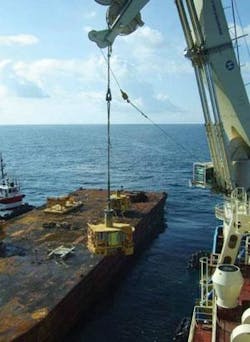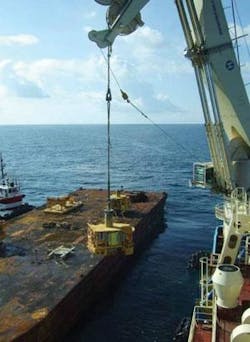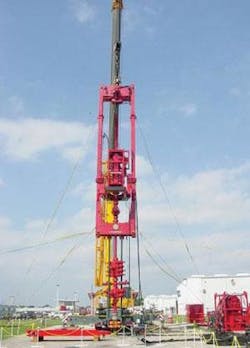Today’s deepwater well interventions usually require big drilling rigs to place and pull heavy risers, but engineers visualize vessel-based, rigless interventions in future.
Demand for oil and natural gas is driving operators to search for new resources at greater depths. It’s no longer unusual to spend as much as $100-150 million to drill a well in 5,000-10,000 ft of water to reach reservoirs at 25,000-30,000 ft TVD.
As these deepwater wells age and components wear, there will be an increasing need for deepwater intervention services and an increasing demand for cost-effective, rigless alternatives.
Chevron, BP, and three technology providers discussed deepwater interventions at a deepwater and emerging technologies group meeting in Houston in late April, sponsored by the American Association of Drilling EngineersHouston.
Today
Current interventions require large floaters to set marine riser and kill a well and can cost $30-90 million. Most of that is in vessel day rates, and only about 5% is allocated for equipment, said Gary Ring, Blade Energy Partners.
The current average reliable operating life of artificial lift systems has been accepted by operating companies as follows:
- Gas lift valves (high opening pressure); 7 years.
- Large seafloor pumps (twin-screw, helicoaxial, single phase); 4-5 years.
- High-speed downhole turbine pumps (electric, hydraulic submersibles); 2-2.5 years.
- Downhole twin-screw pump; little data are available, but this pump has the same motor as the ESP.
There can be a great deal of downtime and lost production during deepwater interventions, Ring pointed out, and vessel availability can be limited on short notice.
Replacing a downhole pump can require 35-40 days, plus 2-17 days’ lead time. Replacing a modular seafloor pump can take 6-14 days, with 2-6 days’ lead time. Replacing a riser pump can take 2-5 days.
Given the time requirements and current day rates, Ring said there’s a greater emphasis on seafloor lift systems than downhole systems. If the anticipated intervention costs less, installing artificial lift on more wells will make sense, fiscally.
Ring suggested several low-cost approaches:
- Use a deep-set master valve, which allows deeper pump placement without the need to set a riser and kill the well.
- Use coiled-tubing reentry through a subsea intervention lubricator system (SILS).
- Install a pressure canister at the wellhead.
Artificial lift
Reservoir pressure depletion is one of several potential problems that would require intervention. The DeepStar joint industry project to develop deepwater technologies, addressed artificial lift (OGJ, May 5, 2003, p. 66; www.deepstar.org).
Ring said “Only 5-10% of the available resource [in deepwater wells] can be produced without reservoir pressure maintenance or artificial lift. We can increase the percentage by increasing the reservoir pressure or by lowering the hydrostatic pressure in the well.”
Reservoir pressure can be increased with gas or water injection, but this requires large volumes of fluids and corresponding large pumps and high pump rates. Injection also requires dedicated injection wells, which are expensive and time-consuming to drill in deep water.
Gas lift, in either the riser or downhole, will lower the hydrostatic pressure, but the benefit derived depends on the crude composition, including the API gravity, bubble point, and GOR watercut. A steady supply of gas is required. After a point, frictional loss in the tubing overcomes any advantage. Also, long horizontal flow lines can lead to slugging if there’s an inversion between the riser and the wellhead, Ring said.
Pumping is easiest and cheapest in the riser, followed by seafloor pumps, but downhole pumps provide the greatest benefit (most reservoir drawdown). Seafloor pumps include twin screw, helicoaxial, single phase pumps, electric submersible pumps (ESPs), and hydraulic submersible pupms (HSPs). Downhole pumps are limited to ESPs, HSPs, and a single manufacturer for twin-screw pumps, according to Ring.
2007 milestones
“Operators last year planned for future deepwater interventions and set records with some 2007 equipment installations,” Ring said.
In the deepwater Gulf of Mexico (8,000 ft) and Brazil (6,250 ft), Shell installed:
- Subsea gas separation equipment.
- Centralift ESPs.
At its Gulf of Mexico King field (5,500 ft), BP installed dual Bornemann twin-screw, multiphase pumps operating in parallel, 18 miles from the Marlin platform (OGJ, Oct. 8, 2007, p. 49).
Wet vs. dry trees
Rob Perry, deepwater and subsea technical director at BP America Inc., discussed the historical gap between subsea (“wet”) and dry tree fields. The installed base of subsea trees is increasing and the technology is maturing, he said, although wet trees have typically been used in fields with lower reservoir complexity.
Examining intervention frequency and type, Perry noted that wireline is used most frequently for intervention, followed by coiled tubing, and lastly, rigs. Most interventions are carried out on dry trees, but the disparity between wet and dry decreases when coiled tubing and rigs are used.
DW hurdles
Chevron Corp.’s Ricky Cummings said several questions face the industry:
- Gauging the differential pressure limits of BOP equipment.
- Critical timeline to develop 15,000-psi subsea well intervention equipment.
- Efficacy of using multiservice vessels (MSVs) in place of mobile offshore drilling units (MODUs).
BOP reliability
Several operators (BP PLC, Chevron, Devon Energy Corp.), contractors, and the US Minerals Management Service participate in a joint industry project on BOP reliability, chaired by Chevron’s Frank Gallander. The JIP’s mission is to add overall efficiency to operations while maintaining high standards, reliability, safety and environmental stewardship.
Internally, Chevron has identified critical components and single points of failure to assist in the selection of capable drilling rigs.
Deepwater BOPs can be subject to negative differential pressures, and this is most often seen in completion and intervention work, Cummings said. Among the components affected by negative differential pressures are ram bonnets, ring gaskets (in BOPs and elsewhere), subsea flexible hoses, and choke and kill valves.
High-pressure equipment
Most “high-pressure” systems are tested to 10,000 psi, but an increasing number of deepwater projects require equipment capable of 15,000 psi. Operators drive the development of equipment and speakers noted they will have to share the risk in order to sustain the pace of research.
Chevron faced the need for higher pressure subsea well intervention equipment in the Gulf of Mexico, where the company has six deepwater wells at its Tahiti project (4,100 ft WD; Green Canyon Blocks 596, 597, 640, 641), and four at Blind Faith (7,000 ft WD; Mississippi Canyon Blocks 695, 696), and the Jack-2 well (7,000 ft WD; Walker Ridge Block 758).
Chevron expects to begin production at Blind Faith in 2008 (OGJ, Dec. 17, 2007, p. 33). Originally scheduled for 2008 production, completion of the Tahiti facilities was delayed because of a metallurgical problem with the mooring shackles (OGJ, July 23, 2007, p. 9). The company has installed subsea production trees and will run the BOP down with the riser to save trips.
Cummings pointed out the limitations of using coiled tubing, which reaches its fatigue limit after only six runs at full working pressure of 15,000 psi at these water depths. Chevron is still developing a compensated CT lift system that can be used on MODUs, he said.
MODU vs. MSV?
Mobile offshore drilling units offer more deck space than multiservice vessels, but MSVs often cost less, can handle multiple ROVs, and can provide offline rig operations. Many are foreign flag vessels, however, and thus forbidden under US cabotage laws (Jones Act, 1920) from transporting materials in US waters. This complicates subsea tree handling, Cummings said. The trees must be carried from port on a barge and transferred to a foreign-flag MSV on site (Fig. 1).
Chevron has two new dynamically positioned vessels with active-heave drawworks that will “play an important role” in the company’s Gulf of Mexico projects, said Cummings, as well as a new inline direct-line compensator for DP rigs.
Systems integration testing is expensive, but critical, Cummings said (Fig. 2). “Know your systems, know what they’re capable of, and carefully examine the worst case scenario for differential pressurea completely evacuated system.”
Shell UK Ltd. has employed the DP-enabled MSV Seawell since May 2000 for light well interventions in the North Sea. Shell renewed its commitment for a minimum utilization of 185 days/year from 2007-10 with Well Ops UK Ltd., a wholly owned subsidiary of Helix Energy Solutions Group Inc., and has options for an additional 60 days/year.
The MSV Seawell has operated in the North Sea exclusively since 1987, during which time it has performed well intervention services on more than 600 subsea wells and decommissioned more than 150 wells.
Future LWI
Helix is building a second LWI vessel, the WOUK Well Enhancer, that will be coiled tubing-capable and carry an intervention riser tested to 10,000 psi. CT intervention is only done through rigid risers. “More and more we’ll see that coiled tubing will be an important tool for interventions,” said Helix’s Kurt Hurzeler.
There’s only one 15,000-psi intervention riser in the world, used by BP on its deepwater Thunderhorse project (6,300 ft) in the Gulf of Mexico.
BP’s Perry sees vessel-based, rigless intervention in the future. The number of deepwater wells is growing with time and will eventually reach a critical mass. This install base and high oil prices will eventually result in the building of dedicated intervention vessels.
Perry said industry should create a list of wells that are candidates for subsea intervention, consider well intervention vessels, and avoid scope and cost creep.
“A small step doesn’t get us fareither for operators or suppliers. It has to be a big jump to change the game.”
A new light well intervention ship, Island Constructor, is currently under construction and will have FMC’s subsea lubricator system (SIL). The ship may be outfitted for CT intervention in the future, but this will require adding a marine riser. The Island Constructor is owned by Marine Accurate Well ASA (MARACC) operated by Island Offshore Management AS. BP has the ship under contract from mid-2008 with several options to extend.



